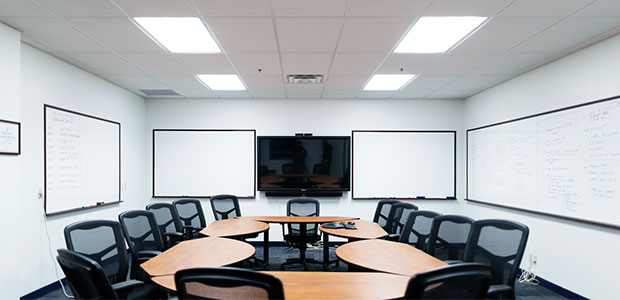
Flicker-Free LED Lighting and Healthier Workplaces: An Analysis
In the quest to ensure a healthier, safer and more productive work environment, lighting innovations can be a central factor. The advent of flicker-free LED lighting offers a promising alternative to fluorescent, incandescent and early-generation LED lighting, even as it significantly reduces maintenance costs.
- By John Davenport
- Nov 06, 2019
In the quest to ensure a healthier, safer and more productive work environment, lighting innovations can be a central factor. The advent of flicker-free LED lighting offers a promising alternative to fluorescent, incandescent and early-generation LED lighting, even as it significantly reduces maintenance costs. For a wide range of stakeholders within the occupational health and safety arena, it is worth assessing the general characteristics of flicker-free LED lighting and the advantages it presents to various workplaces, as well as the outcomes of its implementation.
Flicker-Free LED Lighting Is a Bold Step Forward
Flicker is unsteadiness in light. We can consciously track unsteadiness in light or flicker up to about 80 times per second. If a light source is flickering faster than 80 times per second1—for example, at the power line power frequency of 120 times per second—our bodies still respond to the light’s fluctuations even though we may not “see” them. Like the more visible forms of flicker, this “invisible” form flicker can have a negative impact on health, wellness and productivity.
The most common cause of flicker in a light in is a result of the AC power line modulating the power to the light source. When the power to the light source changes, the light output changes—unless the circuit in between prevents it. While electronic ballast-driven fluorescents greatly reduced this light fluctuation—or flicker—versus their magnetic ballast-driven predecessors, most early-generation LED products reintroduced high flicker rates into indoor environments.
Everyone is sensitive to flicker to some degree. It may contribute to headaches, eyestrain and fatigue; research also suggests it can exacerbate migraines. Certain individuals, such as those on the autism spectrum, experience visual hypersensitivity, where lighting triggers can result in heightened symptoms. Flicker can also induce seizures in people with photosensitive epilepsy. While there are no standards that require lighting manufacturers to remove flicker, the Institute of Electrical and Electronics Engineers (IEEE 1789) indicates that having less than five percent flicker (at power line frequency) presents a low risk to these populations.
Flicker-free LED lighting has been developed to avoid these drawbacks—allowing us to reap the many other benefits of LED lighting. The LED lamp spectrum, which can be continuous rather than spiky like the fluorescent spectrum, provides a closer match to that of natural sunlight, which results in better color differentiation, brighter whites, better color saturation and overall better color vision. As a result, LED lighting can potentially boost mood and concentration levels as well.
Educational, Healthcare, Military and Commercial Workplaces Can Benefit
Evidence for these benefits derives from studies on the impact of flicker-free LED lighting in the educational, healthcare, military and commercial/industrial sectors. For example, in the classroom, the superior qualities of LED lighting improve visibility, which in turn can result in an enhanced learning environment. Published studies suggest students can focus on their classwork more closely under flicker-free LED lighting, while additional research has identified improvements in the behavior of special-needs students.
In healthcare facilities, not only can flicker-free LED light translate into a reduced risk of error among doctors and nurses during medical procedures, but the dimmable/tunable functionality of cutting-edge LED lighting also allows subtle color changes that can facilitate patient wellbeing.
Meanwhile, the U.S. Navy is reaping the benefits of retrofitting its surface ship lighting to flicker-free LEDs; over the past several years, hundreds of thousands of LED lights have been installed. In addition to significant savings on maintenance costs, the improved quality of the light enhances attention, productivity and alertness among crew members.
Finally, the commercial use of flicker-free LED lighting has been shown to improve the appearance of merchandise on display in showrooms and other large public spaces, and to provide a brighter environment for shoppers while ensuring that sales staff working extended shifts enjoy the same health benefits as those outlined earlier.
Retrofitting With Flicker-Free LED Lighting Has Generated Positive Outcomes
Numerous case studies attest to these benefits in real-world settings. For example, Rushwood Elementary School, located outside Cleveland, Ohio, retrofitted flicker-free LED lighting into its existing light fixtures several years ago. In the wake of this change, teachers and students immediately noticed differences: they described the light quality as crisper, clearer and brighter, with words on paper easier to read. One teacher reported getting fewer headaches, and a special-needs teacher noted a more “mellow feel” in her classroom.
Meanwhile, Russell Medical Center, located in Alexander City, Alabama, was looking for a lighting solution to not only reduce energy consumption but also provide a reliable and healthy source of light for its patients and staff. Following a 319,000-square-foot retrofit with 10,000 flicker-free LEDs, both maintenance staff and healthcare providers working at the facility praised the improved light quality.
The U.S. Navy has reported that flicker-free LED lighting is not only increasing energy efficiency aboard ships but also reducing fuel costs, cutting weight, significantly reducing maintenance costs and improving sailor safety. And at the Hartville Marketplace & Flea Market in Hartville, Ohio, a retrofit to flicker-free LED lighting has, according to its president, made the food, jewelry and clothing on sale look more appealing to customers, and resulted in a more welcoming atmosphere overall for customers and sales staff.
Given this successful record, flicker-free LED lighting is plainly an option worth serious consideration for those engaged in the construction and retrofitting of workplaces. The health, safety and economic advantages it offers are significant and point toward a future of greater productivity and a more satisfied workforce.
REFERENCES
1ASSIST, Recommended metric for assessing the direct perception of light source flicker Volume 11, Issue 3 January 2015, p.5.